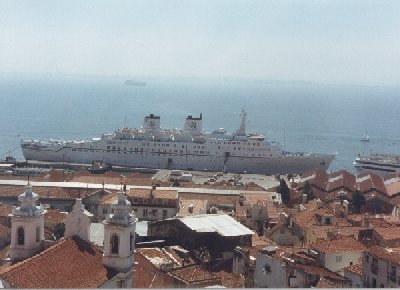Ships and Lisbon

Above, the cruiseship "Crystal Serenity" heads downstream in May, 2007, as a ferry from Cacilhas comes in to the Cais do Sodré landing stage.
Lisbon owes its importance to its natural location in a natural harbour on the River Tagus (Rio Tejo), about 10km from its mouth with the Atlantic Ocean. Although the original inlet is now filled in by the Baixa area of central Lisbon, the city still has extensive docks. These occupy the Alcântara area to the west of Lisbon and the riverside to the east between the centre of the city near Santa Apolónia station and Parque das Nações, (the Expo 98 location), which itself occupies the former docks at Olivais.
Private pleasure craft docks are also to be found at Belém. Lisbon's docks and marinas are operated by APL- Administração do Porto de Lisboa, S.A, whose headquarters are at Rua de Junqueira, 94, 1349-026 Lisboa, (tel: 21-261-1044, fax: 21-361-1005).
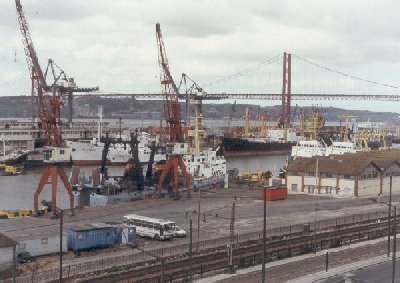
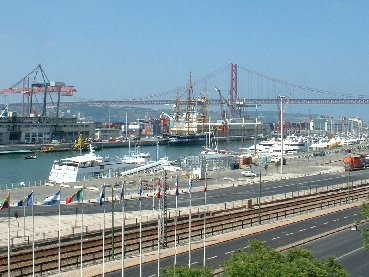
The transformation of Alcântara docks with the Ponte 25 de Abril (bridge) in the background and the railway line to Cascais in the foreground can be seen with left a 1990s' view of commercial activity and, right, a 2003 picture with no foreground cranes and the dock now full of leisure craft including the D. Fernando e Glória 'tall-ship' (of which more is below...).
An intensive service of river ferries used to operate from the Cais da Alfãndega (or Terreiro do Paço), adjacent to the Praça do Comércio, and the next-door Estação do Sul e Sueste in central Lisbon, as well as from Cais do Sodré and Belém. However, from summer, 2000, the Cacilhas ferry service was supposedly only "temporarily" transferred from Alfãndega to Cais do Sodré but remains at the latter location where a large permanent terminal has now been built - see the Ferries Page for details.
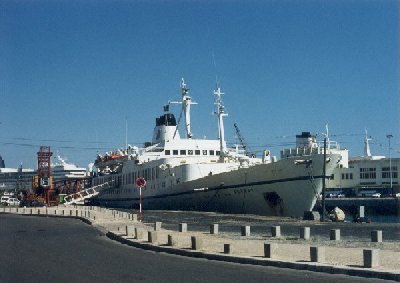
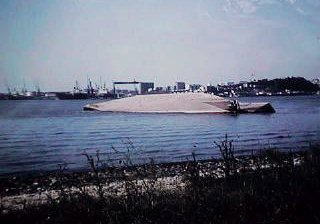
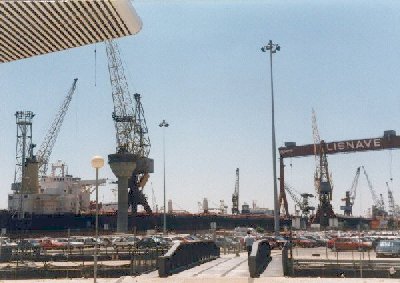
L to R: The liner 'Astra' in Alcântara dock, 1999; Not all the ships which enter the Tagus leave again; the wreck of the MV Tollan, a British cargo ship which sank near the Pç do Comércio on January 11th, 1980. The former Lisnave shipyards are visible across the river; a closer picture of the same Lisnave yards, adjacent to the Cacilhas ferry terminal.
Across the river from Lisbon was the site of the major ship repair/building yards of the Lisnave (Esatleiros Navais de Lisboa) company, whose forerunner was founded in Lisbon in 1937. It moved across to the south bank of the Tagus c1960. By the late 1990s the main shipbuilding facility at Margueira (Almada) had been closed and supplanted by the Setenave facility at Mitrena (near Setúbal), taking his heavy industry further away from large centres of population. The company was, at one time, the largest shipbuilder in Europe. On the Lisbon side, the Alcântara docks have undergone transformation as former dock buildings are converted into nightclubs and bars but cruise liners also still use here although most now dock further upriver near Santa Apolonia (see below).
Doca de Alcântara/ Alcantara Dock
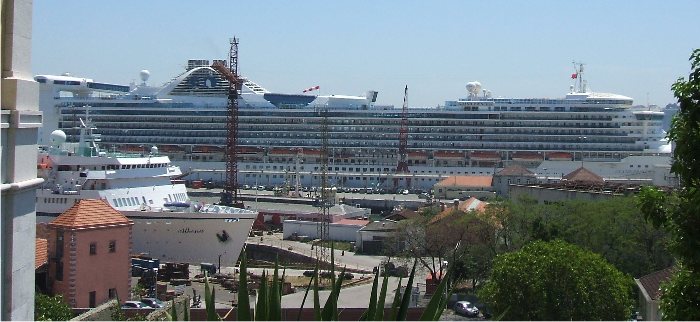

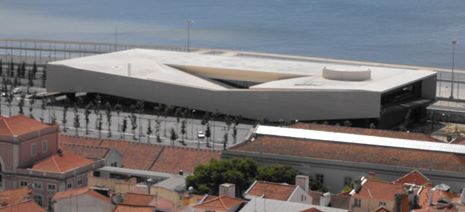
Above left: Alcântara docks in May 2007, hosting (left) the "Athena" and in the background, the "Grand Princess"; right: "Disney Magic" tied up, right outside Santa Apolónia station, in 2010; the cruise ship terminal 2019
This dock now largely handles container ships though cruise liners can also be accommodated. There are two major historical terminal buildings at the docks. The one nearer to the city is the Gare Marítima de Rocha Conde de Óbidos (1940), whilst a little further on is the Gare Marítima de Alcântara (1943). Both are works of the architect Pardal Monteiro and their interiors are worth seeing for their indoor murals by the 20th-century artist Almada Negreiros. The two terminals are also now being marketed as leisure facilities, with restaurants, exhibition spaces and adjacent esplanades.
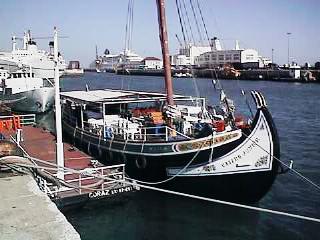
Right: In the docks at Alcântara: a traditional river boat.
Doca de Santos and Cais do Sodré
There has been a significant amount of demolition of warehouses and other dockside buildings between Cais do Sodré and Alcântara, whilst some of the remaining buildings have been coverted into bars and discotheques. Cais do Sodré remains active as a ferry terminal and, indeed, as explained above, since 2000 has seen much more traffic as the Cais da Alfândega services to Cacilhas and elsewhere have been transferred here.
Doca de Santa Apolónia
This dock, a few hundred yards to the north of the Sul e Sueste ferry terminal has become another dock for passenger vessels, having formerly been a purely cargo site. A new cruise liner terminal has been built here.
Doca do Terreiro de Trigo
Adjacent to the above dock, merchant ships, including container ships berth here.
Lisbon has an impressive maritime museum, the Museu de
Marinha at Belém. Adjacent to it is the Gulbenkian planetarium (1960).
subma
Marinas
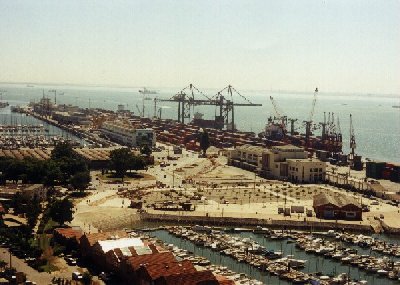
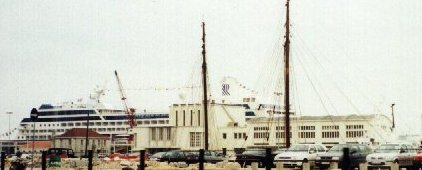
L to R: The docks and marina at Alcântara, as seen from the Ponte 25 de Abril; a passenger vessel behind the terminal at Alcântara.
There are facilities for mooring private vessels in Lisbon at the following locations:
Doca de Alcântara
Here 221 vessels up to 25 metres in length may be berthed, close to the heart of Lisbon. An adjacent riverside walkway has been created, called the Passeio Ribeirinho.
Doca de Santo Amaro
329 boats of up to 25m length can be accommodated here, about 150 metres east
of the suspension bridge, the Ponte 25 de Abril. As elsewhere along the riverfront, this area is being upgraded as a leisure area, with bars and discotheques.
Doca de Belém and Doca do Bom Sucesso
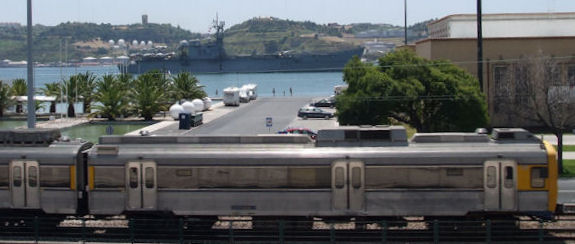
Above: A Cascais-bound train passes Belém as the Spanish Navy's aircraft carrier "Príncipe de Asturias" heads down the Tagus to the Atlantic, June 2008.
These two adjacent facilities, 700 metres apart, to the west of Lisbon accommodate 92 and
199 boats of up to 25m length. The former lies next to the striking monument
to Henry the Navigator, whilst the latter is adjacent to the Manueline Torre de
Belém.
Doca do Terreiro do Trigo
This dock lies to the east of the Sul e Sueste
ferry terminal in central Lisbon and vessels entering and leaving have to
avoid the heavy ferry traffic as well as naval vessels which use the adjacent dock and are a fairly frequent sight in the river off Lisbon.
Marina Expo
This is a large facility at the Parque das Nações catering for 1,100 boats of up to 50m length.
Temporary Facilities: Expo 98
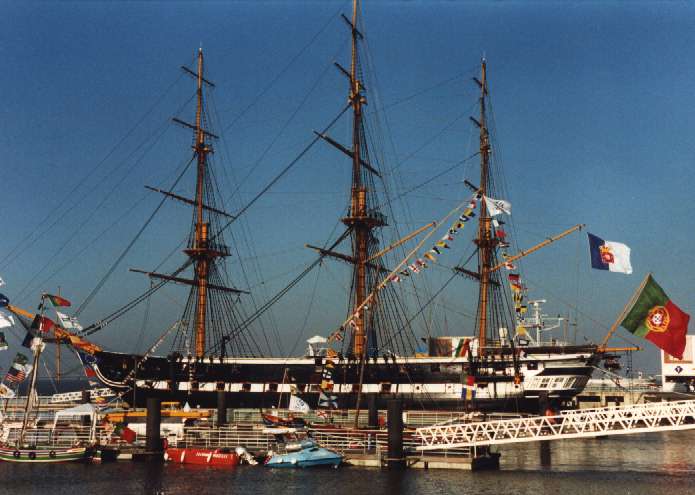
Visiting craft to Expo 98 included historic ships, such as the 'D. Fernando e Glória' as seen here and later moored, first, at Alcântara, and by 2008 at Cacilhas.
Lisbon hosted the Expo 98 international exhibition, which was held on a site constructed on former docklands at Olivais, some 10km north of the Alcântara docks.
The theme of the exhibition was 'The Oceans' and some of the international pavilions had exhibits of maritime interest- although not the British one,
which was almost certainly the most tacky of the displays. Outdoors, there was a changing array of visiting ships, ranging from reproductions of historic
ships, such as Portuguese caravelas, to regional craft from around the country.
A catamaran service was also introduced to bring visitors into the Expoarea from Cascais. The site is since 1999 has been termed the Parque das Nações.
Shipping Services
A number of Lisbon newspapers used to produce daily lists of shipping movements in the port of Lisbon. Literally dozens of destinations are served, mostly by container vessels.
British ports are served from Lisbon by companies which until recently (at least)include the following:
K Line (Kawasaki Kisen Kaisha Ltd), which operated a weekly service to Felixstowe and Newcastle. Their Lisbon contact number is 21-321-13-30,
fax 21-342-50-03, e-mail KLINE@LIS.GL.PT
Ellerman ran a weekly service to Liverpool, Glasgow, Dublin and
Belfast. Their agent is MacAndrews Lda, Cais das Oficinas, Rocha Conde d'Óbidos,
1399-038 Lisboa, tel. & fax: 21-392-50-00.
Mediterranean Shipping Company also had a service to Felixstowe. Their offices are
at Avenida 24 de Julho, 6, 1200 Lisboa, tel: 21-392-84-10; e-mail: msc@msclis.mscgca.ch
Traditional Vessels
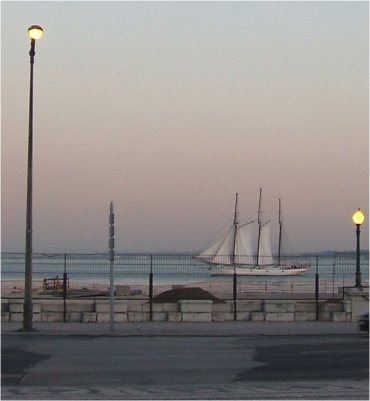
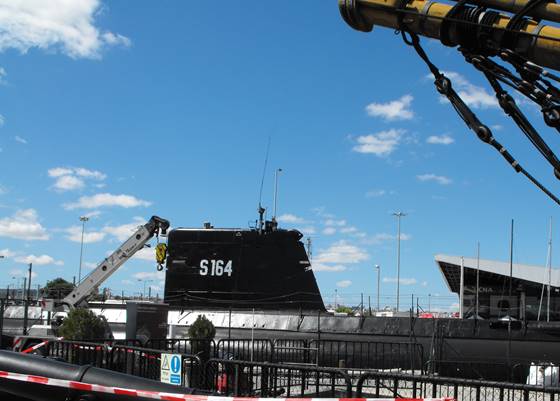
Above: A sailing ship is seen passing the Praça do Comércio one evening in May 2007; Submarine S164 at Cacilhas.
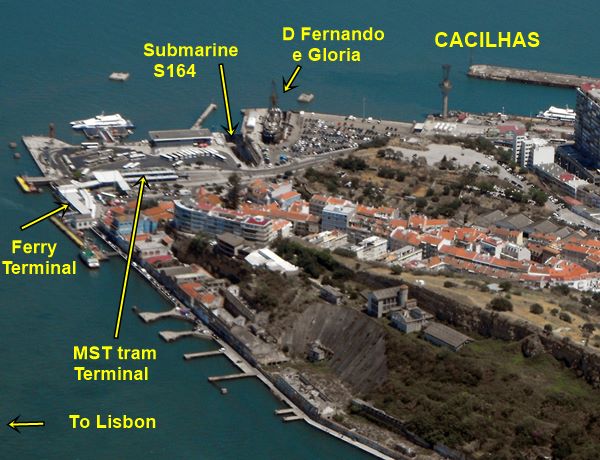
The 'D. Fernando e Glória' can now be visited in its dry dock adjacent to the ferry terminal at Cacilhas, which is easily reached by ferry from Cais do Sodré. Next to it, in another dry dock is a retired Portuguese submarine (S164), which has also been restored.
A number of traditional boats are on show in the Museu de Marinha at Belém. Several of the local Town Councils in the towns on the south bank of the Tagus also maintain traditional river craft which, in some cases, may be hired. These include:
- ALCOCHETE - a "bote de meia-quilha" called Alcatejo was restored to service in 1989 by the Câmara Municipal de Alcohete (tel: (01) 2340080).
- MOITA - the Town Council has two "botes de meia-quilha" called A Pombinha and a "varino" called O Boa Viagem. Tel (01) 2894540.
- MONTIJO - A "canoa" Deolinda Maria, built in 1960, was acquired by the local council in 1992 from a fishermen's cooperative, Four years later the fishing vessel Lubélia Maria was acquired and in 1995 the Jorge Rui. Tel. (01) 2310962.
- SEIXAL - The Council owns a "varino" Amoroso and the "botes de fragata" Gaivotas and Baia do Seixal. Tel. (01) 2227054.
Links
An excellent, illustrated site, is Ian Boyle's which covers a visit to Lisbon by the cruise ships
Aurora and Grand Princess
Copyright 2016: ©
Contact: the following is not a link; please transcribe the address into your email 

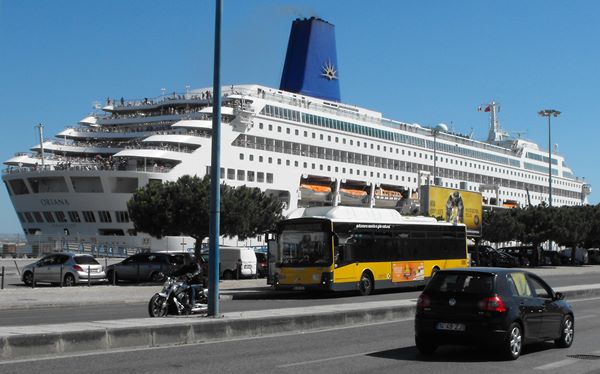
 June 2019
June 2019
